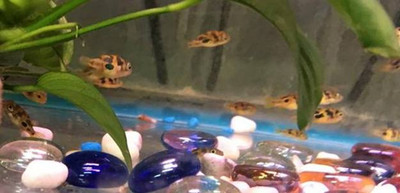Pea Pufferfish
Posted by Max Gandara on on 24th Sep 2025
The Pea Pufferfish (Carinotetraodon travancoricus), also known as the Dwarf Puffer or Malabar Puffer, is one of the smallest freshwater pufferfish species in the world. Despite their tiny size—adults typically reach only about 1 inch—they are full of personality and can be incredibly engaging to watch. Known for their bright coloration, round bodies, and curious nature, Pea Puffers are a favorite among aquarists who enjoy observing intelligent and interactive fish.
Pea Puffers are native to slow-moving rivers, streams, and freshwater pools in India. In captivity, they thrive in planted aquariums with plenty of hiding spots, such as moss, plants, driftwood, and caves. These hiding areas are essential to make them feel secure, especially in a community tank. They are highly active and enjoy exploring their surroundings, so a well-decorated tank with open swimming spaces and safe boundaries is ideal.
While small, Pea Puffers are known for their bold and sometimes territorial behavior. They are best kept in species-specific tanks or carefully selected communities with peaceful, slow-moving fish. Males can be territorial toward each other, so keeping one male with multiple females is often recommended to reduce aggression.
Diet is an important aspect of Pea Puffer care. They are carnivorous and prefer a diet of live or frozen foods, such as brine shrimp, daphnia, bloodworms, and snails. Feeding live snails also helps wear down their ever-growing teeth, which is vital for their health. Pea Puffers are not typically interested in flakes or pellets, so a varied live or frozen diet is essential.
These tiny puffers are intelligent and curious, often interacting with their owners and showing distinct personalities. With proper care, Pea Pufferfish can live up to 5 years in a well-maintained aquarium. Their small size, playful behavior, and unique appearance make them an excellent choice for aquarists looking for a charming and fascinating addition to a nano or small freshwater tank.

